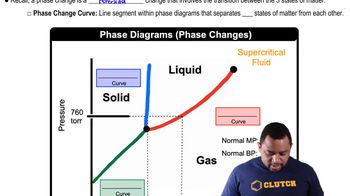(d) Does the amount of work that a system can do on its surroundings depend on the path of the process?
Ch.19 - Chemical Thermodynamics
Chapter 19, Problem 15c
Consider the vaporization of liquid water to steam at a pressure of 1 atm. (c) In what temperature range is it a nonspontaneous process?

Verified Solution
Video duration:
1mWas this helpful?
Key Concepts
Here are the essential concepts you must grasp in order to answer the question correctly.
Gibbs Free Energy
Gibbs Free Energy (G) is a thermodynamic potential that helps predict the spontaneity of a process at constant temperature and pressure. A process is spontaneous if the change in Gibbs Free Energy (ΔG) is negative. For the vaporization of water, understanding how temperature affects ΔG is crucial in determining the conditions under which the process becomes nonspontaneous.
Recommended video:
Guided course

Gibbs Free Energy of Reactions
Phase Equilibrium
Phase equilibrium refers to the state where the rates of vaporization and condensation of a substance are equal, resulting in no net change in the amount of liquid and vapor. At 1 atm, water vaporizes at 100°C. Below this temperature, the equilibrium shifts towards the liquid phase, indicating that vaporization is nonspontaneous as the system favors condensation.
Recommended video:
Guided course

Phase Changes in Diagrams
Clausius-Clapeyron Equation
The Clausius-Clapeyron equation describes the relationship between the pressure and temperature of a substance during phase changes. It provides insight into how the vapor pressure of water changes with temperature, which is essential for understanding the conditions under which vaporization occurs. This equation helps identify the temperature range where vaporization is nonspontaneous by relating it to the pressure of the system.
Recommended video:
Guided course

Clausius-Clapeyron Equation
Related Practice
Textbook Question
617
views
Textbook Question
Consider the vaporization of liquid water to steam at a pressure of 1 atm. (a) Is this process endothermic or exothermic?
654
views
Textbook Question
Consider the vaporization of liquid water to steam at a pressure of 1 atm. (b) In what temperature range is it a spontaneous process?
443
views
Textbook Question
Consider the vaporization of liquid water to steam at a pressure of 1 atm. (d) At what temperature are the two phases in equilibrium?
789
views
Textbook Question
The normal freezing point of n-octane (C8H18) is -57 °C. (b) In what temperature range is the freezing of n-octane a spontaneous process?
747
views
Textbook Question
The normal freezing point of n-octane (C8H18) is -57 °C. (d) Is there any temperature at which liquid n-octane and solid n-octane are in equilibrium? Explain.
612
views
